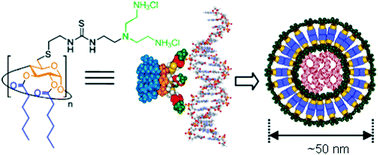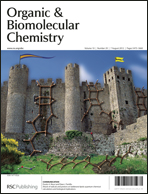Polycationic amphiphilic cyclodextrins as gene vectors: effect of the macrocyclic ring size on the DNA complexing and delivery properties†
Abstract
A collection of homologous monodisperse facial amphiphiles consisting of an α-, β- or γ-cyclodextrin (α, β or γCD) platform exposing a multivalent display of cationic groups at the primary rim and bearing hexanoyl chains at the secondary hydroxyls have been prepared to assess the influence of the cyclooligosaccharide core size in their ability to complex, compact and protect pDNA and in the efficiency of the resulting nanocondensates (CDplexes) to deliver DNA into cells and promote transfection in the presence of serum. All the polycationic amphiphilic CDs (paCDs) were able to self-assemble in the presence of the plasmid and produce transfectious nanoparticles at nitrogen/phosphorous ratios ≥5. CDplexes obtained from βCD derivatives generally exhibited higher transfection capabilities, which can be ascribed to their ability to form inclusion complexes with cholesterol, thereby enhancing biological membrane permeability. The presence of thiourea moieties as well as increasing the number of primary amino groups then favour cooperative complexation of the polyphosphate chain, enhancing the stability of the complex and improving transfection. In the α and γCD series, however, only the presence of tertiary amino groups in the cationic clusters translates into a significant improvement of the transfection efficiency, probably by activating endosome escape by the proton sponge mechanism. This set of results illustrates the potential of this strategy for the rational design and optimisation of nonviral gene vectors.


 Please wait while we load your content...
Please wait while we load your content...